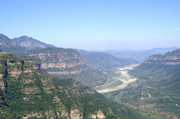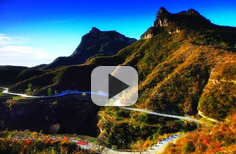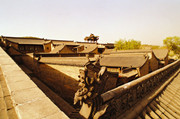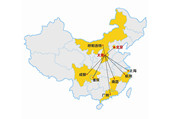Yuncheng, cradle of ancient Chinese culture
( China Daily )
Updated: 2006-07-25
One of the birthplaces of China's ancient civilization, Yuncheng is full of natural and cultural wonders.
East to the Yellow River, Yuncheng is at the southern tip of North China's Shanxi province, with a total area of 14,000 square kilometres and a population of 5 million.
It's long history gathers a wealth of historical and cultural legacies. It has 44 national cultural relic protection units and 90 provincial ones, as well as a national scenic and historic interest area and two national forest parks.
Of great value and high fame are the Yongle Palace in Ruicheng, a fresco treasury of the Yuan Dynasty (1271-1368); the Pujiu Temple in Yongji, the one mentioned in the Story of Yingying by Yuanzhen of the Tang Dynasty (618-907); an ancient stork tower named Guanquelou,one of four noted ancient towers in China; the unearthed iron ox group in the Pujin ferry by the Yellow River, which dates back to the Tang Dynasty; and the well-preserved Lichen primeval forest, the largest of its kind in North China.
Furthermore, Yuncheng witnessed hosts of famous stories in ancient Chinese history, while well-known historic personalities left their legends there to inspire the minds of future generations.
They included Guan Yu, a general in the period of the Three Kingdoms (220-280), renowned for his loyalty and later deified as Guandi or Emperor Guan; Tang Dynasty writer and poet Liu Zongyuan, as well as poets Wang Bo and Wang Wei; Northern Song Dynasty (960-1127) statesman, historian Sima Guang; and Guan Hanqing, a playwright of the Yuan Dynasty with striking literary achievements.
As a cradle of Chinese culture, Yuncheng boasts brilliant folk arts. The Jiangzhou music accompanied by drumbeats caused a sensation among foreign audiences during its overseas performance tour, while the Jiangxian County dragon dance was performed at the opening ceremony of the Beijing Asian Games in 1990.
The adventurous and exciting performance of walking on stilts, the popular Puzhou opera, the skillful and colourful dough modelling, and the superb paper-cuts and embroidery are all among the attractions of Yuncheng for visitors from both home and abroad.
Pujiu Temple
The Pujiu Temple in northwest of Yongji County is the one mentioned in the Story of Yingying by Yuanzhen of the Tang Dynasty (618-907). The pagoda was used for worshiping the Buddha, and no one knows when it got the name of Yingying. The pagoda was built during the Sui (581-618) and Tang dynasties. The existing pagoda in the Pujiu Temple was rebuilt around the year 1521 during the reign of Emperor Jiajing of the Ming Dynasty (1368-1644), but it retained parts of the Tang Dynasty style.
The pagoda is square, each side of the ground floor measuring 8.05 meters. The door on the south side is 1.28 meters wide. The inside chamber is square, but the southern and northern walls are not exactly the same length as the eastern and western walls. The door is not in the exact middle, too. There is a niche on the back wall, but the statue of Buddha is missing. No stairs are installed on the first storey; the ceiling is an octagonal dome with a hole in the middle opening to the upper floor. There are 13 eaves built by tiles. As to the lower 7 storeys, the distance from one eave to another gradually and obviously reduces from the lower one to the higher one. Above the 7th storey, the distance is comparably lessened, which are obviously added in the Ming Dynasty. The holes left by poles injected into the pagoda to fix the scaffold can still be seen, which tells the situation of construction at that period.
Guanquanlou
Guanquanlou was one of the four noted ancient towers in China. The other three towers were the Huanghelou, Yueyanglou and Tengwangge (Yellow Crane Tower, Yueyang Tower and Tengwang Pavilion), located in Hubei, Hunan and Jiangxi provinces respectively.
Standing near the bank of the Yellow River, Guanquanlou was originally built in the Northern Zhou Dynasty (557-581) for military purposes. As a vantage point, it also attracted literati and poets of past dynasties to climb it to see a panoramic view of the beauty of the landscape, including the Tang poet Wang Zhihuan, who wrote the famous poem "On the Stork Tower".
Unfortunately, the original tower was ruined in the war during the Yuan Dynasty.
Rebuilt in 2001, the new six-floor tower, 73.9 metres in height, follows the construction style of the Tang Dynasty. Murals in the tower display the personal stories, historical legends and humanistic culture of the eastern Yellow River area.
Emperor Shun's Tomb
Ten kilometres to the north of downtown Yuncheng, Emperor Shun Tomb is a holy place for Chinese people to offer sacrifices to their ancestors.
Emperor Shun, the ninth-generation grandson of Huangdi or Yellow Emperor, was a clan alliance leader of the primeval society who succeeded Yao due to his outstanding morality.
As a legendary sage monarch in ancient China, Shun made vigorous efforts to build a strong country by appointing officials on their merits, developing the economy and educating the people.
Emperor Shun Tomb is mainly divided into two parts. The southern part consists of the Emperor Shun Avenue, the Emperor Shun Square and the Emperor Shun Park, while the northern part includes the outer city, the cemetery and the Imperial City.
Standing along the tomb passage are five ancient cypresses, more than 4,000 years old. It is even more amazing that each cypress embraces a dead one, so they are known as "Couple Cypresses."
Salt Lake
Dubbed China's Dead Sea, the Yuncheng Salt Lake covers a total area of 132 square kilometres with a development history of 5,000 years.
It is rich in mineral elements, while its black mud contains the same basic elements as that of the Dead Sea in Israel, which can be used to activate cells, refresh the skin, and relieve fatigue.
A large-scale drifting bathing centre and a black-mud healthcare pool were built in the vicinity of the lake several years ago, attracting increasing numbers of tourists to enjoy the salty water swimming, black mud and hot spring bath.




